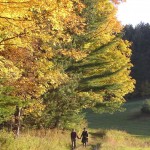
Credit: Polynesian Voyaging Society and ʻŌiwi TV.
In 2013, the traditional voyaging canoe Hōkūleʻa set sail from Hawai’i on a round-the-world journey using only traditional Polynesian wayfinding techniques, including observations of the stars, the sun, the ocean swells, the winds, birds, and other signs of nature. After a journey of over 60,000 miles, visiting more than 23 countries and territories and 150 ports, the Hōkūleʻa returned to Hawai’i on 17 June 2017. The wayfarers carried a message of Mālama Honua – a Hawaiian expression meaning “to care for our island Earth” – and gathered ideas to meet the challenges facing our world today.
And so it was in September 2016 that another journey occurred with similar intentions to the Hōkūleʻa – this one at IUCN’s World Conservation Congress (WCC) in Hawai’i . In the Hawaiian spirit of Mālama Honua, over 8,000 people travelled to Honolulu from around the world to share ideas and learn from each other’s innovations to better address the many conservation challenges facing our planet.
 In the conservation world, the two faces of nature and culture have become more a dichotomy than a duality. And yet, there is growing recognition that only by taking a more holistic approach can the field address the most urgent issues facing our planet – climate change, urbanization, and the transformations wrought by globalization. To explore these challenges a Nature-Culture Journey was launched part of the larger WCC conference. It brought together a broad array ideas that touch on the duality of the nature – culture divide. For example, how the World Heritage Convention has shaped our perceptions of the two fields, the role of indigenous communities, traditional knowledge and spiritual values, and the challenges of conserving agricultural heritage landscapes. While it would be impossible to represent the many threads of dialogue from last September’s journey, an upcoming issue of the George Wright Journal titled Nature – Culture Journeys: Explorations on Shared Terrain is dedicated to highlighting some of these intersections from different fields and different geographies. The Journal provides a dive into some of the most critical topics where nature and culture merge and is a must read for those who recognize the urgency of taking a holistic perspective for a sustainable future.
In the conservation world, the two faces of nature and culture have become more a dichotomy than a duality. And yet, there is growing recognition that only by taking a more holistic approach can the field address the most urgent issues facing our planet – climate change, urbanization, and the transformations wrought by globalization. To explore these challenges a Nature-Culture Journey was launched part of the larger WCC conference. It brought together a broad array ideas that touch on the duality of the nature – culture divide. For example, how the World Heritage Convention has shaped our perceptions of the two fields, the role of indigenous communities, traditional knowledge and spiritual values, and the challenges of conserving agricultural heritage landscapes. While it would be impossible to represent the many threads of dialogue from last September’s journey, an upcoming issue of the George Wright Journal titled Nature – Culture Journeys: Explorations on Shared Terrain is dedicated to highlighting some of these intersections from different fields and different geographies. The Journal provides a dive into some of the most critical topics where nature and culture merge and is a must read for those who recognize the urgency of taking a holistic perspective for a sustainable future.

Credit: Nora Mitchell
To read all of the articles in this issue of the George Wright Journal Nature – Culture Journeys: Explorations on Shared Terrain, you will need to become a member of the society. Note that selected content from this issue is available now and all the content will become available to all readers on line after the publication of the next issue of the Journal.
As a reader of this blog I know you will be interested in this issue of the George Wright Journal and I urge you to consider becoming a member and supporting the mission of the society. The George Wright Society promotes professional research and resource stewardship. As a bridge between science and management, the GWS brings together hundreds of leaders across disciplines in natural and cultural resource management. With members in nearly all 50 U.S. states and numerous countries around the world, the GWS unites a community of Indigenous peoples, resource managers and park staff, researchers, professors, emerging leaders, educators, government agencies, nonprofits and outdoor enthusiasts.
This article draws in part from the work of Nora Mitchell in the Introductory essay to the issue of the George Wright Journal Nature – Culture Journeys: Explorations on Shared Terrain


